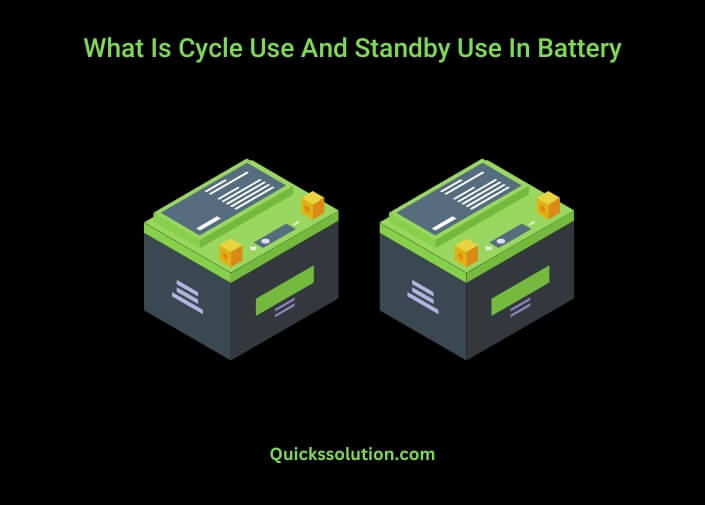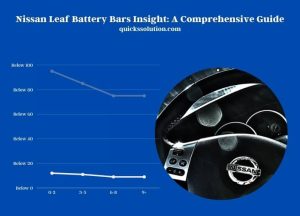Published on: July 14, 2023
Written by Amlan Roy / Fact-checked by Hashim Manna
Cycle use in a battery refers to the regular process of charging and discharging, akin to the ‘working hours’ for a battery. Standby use is akin to ‘standby mode’, where the battery serves as a backup power source, ready to kick in if primary power fails.
The usage of batteries, particularly lead acid batteries, can be classified broadly into two categories: cycle use and standby use. The cycle use in a battery, often specified by a cycle use voltage, pertains to the regular draining and recharging of the battery. This cycling is common in applications like electric vehicles and solar energy storage, where the battery frequently fluctuates between being charged and discharged.

Contrastingly, standby use signifies a battery’s role as a reserve power source. The battery remains mostly charged, with a defined standby use voltage, ready to supply power in situations where the primary source is unavailable or disrupted. This is prevalent in emergency systems and uninterruptible power supplies (UPS) where reliability is paramount.
The voltage associated with cycle use or standby use varies among battery types. For instance, a gel battery typically has a different cycle use voltage compared to a lead acid battery. Moreover, the type of use – cycle use versus float use – greatly influences the longevity and efficiency of the battery.
In sum, comprehending cycle use and standby use is vital for maximizing battery performance and lifespan. Depending on the application, selecting the right battery with appropriate cycle use or standby use voltage can significantly enhance system reliability and operational efficiency.
Cycle Use in Battery
Cycle use refers to the working state of a battery involving regular discharge and recharge patterns.
Voltage Requirement for Full Charge
The Cycle Use voltage represents the power input needed to fully charge the battery. This voltage varies with the type of battery, but in all cases, it is vital for reaching the battery’s maximum potential.
Impact on Battery Cells
Keeping a battery at the full cycle use voltage consistently is not recommended as it can induce stress on the cells. A prolonged state at this voltage can cause premature aging and degrade the battery’s capacity over time.
Typical Applications
Applications that involve frequent battery discharging and recharging, such as solar power systems or electric vehicles, predominantly use this mode.
Standby Use in Battery
Standby use, on the other hand, is the battery’s reserve state, primarily employed as a backup power source.
Maintaining Battery Health
The Standby Use voltage is the power level at which a fully charged battery can be maintained for extended periods without causing significant damage or degradation. This voltage keeps the battery in good condition, ready to provide power whenever needed.
No Continuous Discharge and Recharge
In this use case, the battery is not continuously discharged and recharged as in cycle use. Instead, it is kept at a constant voltage to ensure immediate power availability.
Common Applications
Standby use is common in emergency power systems and Uninterrupted Power Supplies (UPS) where immediate power backup is required.
Cycle Use Vs Standby Use: A Comparison
| Cycle Use | Standby Use | |
| Role | Regular discharging and recharging | Backup power source |
| Voltage | Cycle use voltage for full charge | Standby use voltage for maintaining health |
| Battery Stress | High if kept at full voltage | Low |
| Typical Applications | Solar power systems, electric vehicles | Emergency power systems, UPS |
In essence, whether it’s cycle use or standby use, maintaining the right voltage level is key to battery health and lifespan. Knowing the appropriate use and voltage is fundamental to optimize battery performance in various applications.
FAQs
What Is the Meaning of Cycle Use in a Battery?
Cycle use in a battery refers to the routine process of charging and discharging. This cycle happens in applications like electric vehicles and solar power systems where the battery regularly fluctuates between being charged and discharged.
What Does Standby Use in a Battery Mean?
Standby use represents a battery’s function as a backup power source. The battery remains mostly charged, ready to supply power in situations where the primary source is unavailable. It’s commonly used in emergency power systems and uninterruptible power supplies (UPS).
What Is the Importance of Cycle Use and Standby Use Voltages in Batteries?
The voltages associated with cycle use and standby use are critical as they determine the battery’s charging levels and its standby condition. Maintaining the correct voltage levels can enhance the battery’s performance and lifespan.
What Is the Difference Between Cycle Use and Standby Use in Batteries?
Cycle use and standby use differ mainly in their purpose. Cycle use involves frequent charging and discharging, common in electric vehicles or solar energy systems. Standby use, however, keeps the battery primarily charged, ready to supply power when the primary source fails.
Can You Switch Between Cycle Use and Standby Use in a Battery?
Yes, a battery can switch between cycle and standby uses, but it’s not advisable. Switching between these modes can strain the battery, reducing its effectiveness over time. It’s best to use a battery according to its intended application.
How Does Cycle Use Voltage Differ Across Battery Types?
The cycle use voltage can vary across different battery types. For instance, a gel battery might have a different cycle use voltage compared to a lead-acid battery. This voltage specification plays a key role in the charging process and overall performance of the battery.
Read more:




